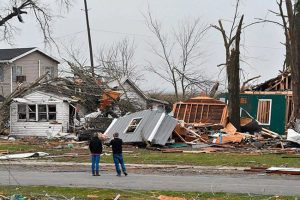When a flood damages your home, the aftermath can be overwhelming. In addition to the emotional distress, there’s the challenging task of navigating the insurance claims process. To help you maximize your insurance claim, we’ve put together a list of essential first steps to take after a flood.
By following this advice, you’ll be in a better position to protect your interests and ensure you receive the coverage you deserve.
Table of contents
Prioritize safety and document the damage
When dealing with a flood, safety should always be the first priority. Before entering your home, be sure to turn off the power and gas supply to avoid any potential hazards. Wear protective gear such as rubber boots and gloves to avoid any health risks from the contaminated water.
Once you’ve made sure it’s safe to enter, start documenting the damage. Take photos and videos of all affected areas from multiple angles. Don’t forget to document any damaged personal belongings, furniture, and appliances, as well as any structural damage. Make a list of all the damaged items, including their value and purchase date if possible. All of this information will be valuable when filing your insurance claim.
It’s also a good idea to create a separate folder or file on your computer to keep all of your documentation in one place. This will make it easier to access and organize when communicating with your insurance company.
If the damage is extensive, you may want to consider hiring a professional to assess the damage and provide an estimate for repairs. This can be especially helpful if you’re unsure of the extent of the damage or if you’re concerned about missing any important details in your documentation.
Remember, the more detailed and comprehensive your documentation is, the easier it will be to negotiate with your insurance company and maximize your claim.
Notify your insurance company immediately
One of the most important steps after experiencing flood damage is to notify your insurance company immediately. The sooner you inform them, the quicker you can start the process of filing a claim and receiving the necessary funds for repairs. Be sure to have your policy number and contact information readily available when you call.
Your insurance company will provide you with important information on the next steps to take, including the required documentation and the procedures to follow when cleaning up and making repairs. It’s crucial to adhere to any guidelines and requirements to ensure that your claim is processed smoothly and efficiently.
When you speak with your insurance company, be sure to ask any questions you may have about the claims process, including any deadlines or timeframes you need to be aware of. It’s essential to stay on top of these deadlines to ensure that you receive the maximum amount of compensation possible for your damages.
Additionally, if you have flood insurance, it’s important to understand the specific coverage and limits of your policy. Some policies may cover certain types of damages or require additional documentation to support your claim. Knowing the details of your policy can help you navigate the claims process and maximize your coverage.
Take steps to mitigate further damage
It’s crucial to take steps to mitigate any further damage to your property after a flood. This can help prevent any additional costs or losses that may not be covered by your insurance policy.
Firstly, removing excess water from your property is a crucial step. This can be done using a wet/dry vacuum or a pump if the water level is high. After removing standing water, it is essential to dry out the affected areas as quickly as possible to prevent mold growth. The use of fans, dehumidifiers, and air conditioning units can help speed up the drying process.
If you have any wet or damaged items, it is important to remove them from the affected area promptly. These items can include furniture, clothing, and carpets. Removing wet items can help prevent mold growth and further water damage to your property.
It is important to document all your mitigation efforts, including photos and receipts, to show your insurance company that you took reasonable steps to prevent further damage. Your insurance company may require this documentation as part of your claim process.
By taking steps to mitigate any further damage to your property, you can help minimize any additional costs or losses that may not be covered by your insurance policy.
Keep track of expenses
In the aftermath of a flood, it’s important to keep track of all expenses related to the cleanup and recovery process. This includes costs for emergency repairs, temporary accommodations, and any other expenses incurred as a result of the flood. Keeping a detailed record of all these expenses can help support your insurance claim and demonstrate the financial impact of the disaster.
Be sure to save all receipts and invoices for materials, equipment, and services used during the cleanup process. This includes costs for drying out the property, removing debris, and restoring the affected areas. Additionally, keep track of any expenses related to temporary accommodations, such as hotel stays or rental properties, if your home is uninhabitable due to the flood.
Keeping track of these expenses can be a daunting task, but it’s important to be organized and detailed. Consider using a spreadsheet or online tool to keep track of expenses and receipts. This will help you stay organized and ensure that you don’t overlook any expenses that may be reimbursable by your insurance company.
Remember that your insurance company may require documentation of all expenses related to the flood damage, so it’s important to keep all records and receipts in a safe and easily accessible place. By keeping accurate records of expenses, you can maximize your insurance claim and ensure that you are fully reimbursed for all flood-related costs.
Consult a public adjuster
While your insurance company may send an adjuster to evaluate the damage, their priority is to save the company money. That’s why it may be beneficial to hire a public adjuster to work on your behalf. Public adjusters are licensed professionals who specialize in evaluating, documenting, and negotiating insurance claims. They can help ensure that you receive the maximum amount of compensation possible for your losses.
A public adjuster can be especially helpful if you have a complicated claim or if your insurance company is denying or delaying your claim. They can provide expert guidance on the claims process, assist in preparing the necessary documentation, and negotiate with your insurance company on your behalf.
It’s important to note that public adjusters do charge a fee for their services, usually a percentage of the settlement amount. However, the cost may be worth it in the long run, as they may be able to help you receive a much larger settlement than you would have on your own.
When selecting a public adjuster, be sure to do your research and choose a licensed professional with a good reputation in the industry. You can also ask for referrals from friends, family, or your insurance agent.
Remember, a public adjuster’s expertise and advocacy can be a valuable asset in maximizing your insurance claim after a flood.
Closing
Flood damage can be devastating, but taking the right steps in the immediate aftermath can make a significant difference in the success of your insurance claim. By prioritizing safety, documenting the damage, notifying your insurance company, mitigating further damage, keeping track of expenses, and consulting a public adjuster, you can protect your interests and ensure you receive the coverage you deserve.
FAQ
Prioritize safety, document the damage, notify your insurance company, and start mitigating further damage.
It provides tangible evidence of the extent and nature of the damage, supporting your claim for compensation.
Prompt notification sets the claims process in motion and helps ensure you meet any policy deadlines.
Removing excess water, drying out the property, and removing wet or damaged items to prevent mold growth and additional damage.
Keep detailed records and receipts of all cleanup and recovery expenses, including temporary accommodations and emergency repairs.
They advocate on your behalf, helping ensure you receive a fair settlement by accurately assessing and documenting damage and negotiating with the insurance company.
Yes, but hiring a public adjuster can provide expertise and peace of mind, potentially leading to a better settlement.
Consider consulting a public adjuster or attorney to review your claim and discuss possible actions, including negotiation or appeal.
No, flood damage is typically not covered by standard homeowners policies; separate flood insurance is required.
Review and understand your insurance coverage, consider purchasing flood insurance, and have a plan for documenting property and mitigating damage promptly.




